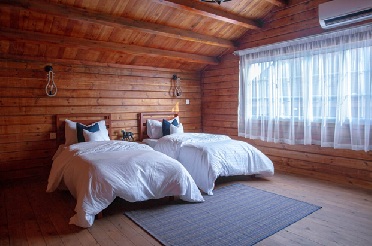 ODESSA, FLA.—Florida’s hospitality industry is thriving, and bed-and-breakfast owners must constantly find ways to improve their properties while keeping operating costs low. With rising electricity bills and increasing demand for sustainable travel, energy-efficient upgrades can help small business owners reduce expenses and attract eco-conscious guests.
ODESSA, FLA.—Florida’s hospitality industry is thriving, and bed-and-breakfast owners must constantly find ways to improve their properties while keeping operating costs low. With rising electricity bills and increasing demand for sustainable travel, energy-efficient upgrades can help small business owners reduce expenses and attract eco-conscious guests.
Many travelers today look for accommodation that aligns with their values, including environmentally friendly lodging. A well-maintained, energy-efficient bed-and-breakfast offers comfort while lowering long-term costs. From reducing water waste to upgrading HVAC systems, several improvements can help owners cut back on utility bills while creating a more sustainable business. Making these upgrades can also increase property value, making it a smart investment for long-term financial stability.
Investing in Solar Energy for Cost Savings
One of the most effective ways to lower energy costs is by switching to solar power. Florida’s abundant sunshine makes it an ideal location for solar energy, allowing bed-and-breakfast owners to reduce their reliance on traditional power sources. While the upfront cost of installing solar panels can be significant, the long-term savings on electricity bills can make it a worthwhile investment.
Many small business owners look for financing options to cover the cost of energy-efficient upgrades. Some explore home equity loan rates in Florida to determine if using home equity is a practical way to fund solar panel installations. This option can provide property owners with the funds they need to invest in renewable energy without taking on additional business debt. By making the switch, bed-and-breakfast owners can benefit from lower monthly utility costs while appealing to environmentally conscious travelers.
Upgrading to Energy-Efficient HVAC Systems
Heating and cooling make up a significant portion of a bed-and-breakfast’s energy consumption. Outdated HVAC systems often waste energy, leading to high electricity bills and inconsistent indoor temperatures. Upgrading to an energy-efficient HVAC system allows owners to maintain guest comfort while lowering energy usage.
Smart thermostats offer additional control by allowing owners to adjust temperatures remotely and set schedules based on room occupancy. These devices help reduce unnecessary heating and cooling when rooms are unoccupied, leading to additional savings. Regular maintenance, such as replacing air filters and checking insulation, keeps HVAC systems running efficiently and extends their lifespan.
Switching to LED Lighting
Lighting is another area where bed-and-breakfast owners can cut energy costs. Traditional incandescent bulbs use more electricity and burn out faster than LED bulbs. Making the switch to LEDs reduces power consumption and lowers maintenance costs, as these bulbs last significantly longer.
Installing motion-sensor lighting in hallways and common areas helps prevent unnecessary energy use. Dimmers provide further control over brightness, allowing owners to adjust lighting levels based on the time of day and guest preferences. By making these small changes, bed-and-breakfast owners can enhance ambiance while reducing electricity usage.
Improving Water Efficiency
Water conservation is just as important as energy efficiency, especially for bed-and-breakfast owners. In a warm climate, water use can increase quickly, leading to high utility bills. Making small changes to how water is used can lower costs and reduce waste.
One of the best ways to improve water efficiency is by installing low-flow fixtures. Modern showerheads, faucets, and toilets use less water without affecting performance. Many hotels and B&Bs have already made this switch, helping them cut water bills while maintaining guest comfort.
Another option is using a rainwater collection system for landscaping. Heavy rainfall provides an opportunity to reuse water for irrigation instead of relying on municipal supplies. Collecting rainwater in storage tanks and using it for gardens and outdoor areas can lower water usage and costs.
Energy-efficient water heaters can also make a difference. Traditional water heaters constantly heat water, even when it’s not needed. Tankless water heaters, on the other hand, heat water only when a faucet is turned on. This reduces energy waste and provides an unlimited supply of hot water for guests.
Enhancing Insulation & Window Efficiency
Many bed-and-breakfasts operate in older buildings, which may have poor insulation and outdated windows. These issues can cause heating and cooling systems to work harder, leading to higher energy bills. Improving insulation is one of the easiest ways to maintain indoor temperatures without using extra energy.
Proper insulation in walls and attics helps keep heat out during the summer and retains warmth in cooler months. Weatherstripping around doors and windows can prevent air leaks, making rooms more comfortable year-round.
Upgrading to energy-efficient windows is another way to reduce energy costs. Modern windows are designed to block heat from entering while keeping cool air inside. If full window replacement is too costly, adding thermal curtains or window films can help regulate indoor temperatures.
Offering Sustainable Amenities for Guests
Providing eco-friendly amenities is a great way to enhance guest experience while keeping costs low. Many travelers appreciate accommodation that makes sustainability a priority, and small changes can make a big impression.
Energy-efficient appliances, such as mini-fridges and coffee makers, consume less electricity while offering guests the convenience they expect. Switching to refillable toiletry dispensers instead of single-use plastic bottles helps reduce waste and costs.
Electric vehicle (EV) charging stations are another great addition. With more travelers driving electric cars, having a charging station can attract new guests while supporting sustainable transportation. Bed-and-breakfast owners who add this feature may see an increase in bookings from eco-conscious travelers.
Linen and towel reuse programs are also effective. Encouraging guests to use towels and bedding for more than one night reduces water and energy use in laundry operations. Providing clear information about these programs helps guests understand how they contribute to sustainability efforts.
Energy-efficient upgrades help bed-and-breakfast owners lower operating costs while making their businesses more sustainable. Whether through solar power, efficient HVAC systems, water-saving fixtures, or better insulation, small improvements lead to long-term savings.
Financing options like home equity loans can provide property owners with the funds needed to invest in green upgrades. These improvements help reduce monthly expenses, enhance guest experience, and make businesses more competitive in today’s hospitality industry. By taking these steps, bed-and-breakfast owners can create a comfortable, cost-effective, and eco-friendly environment for their guests.





